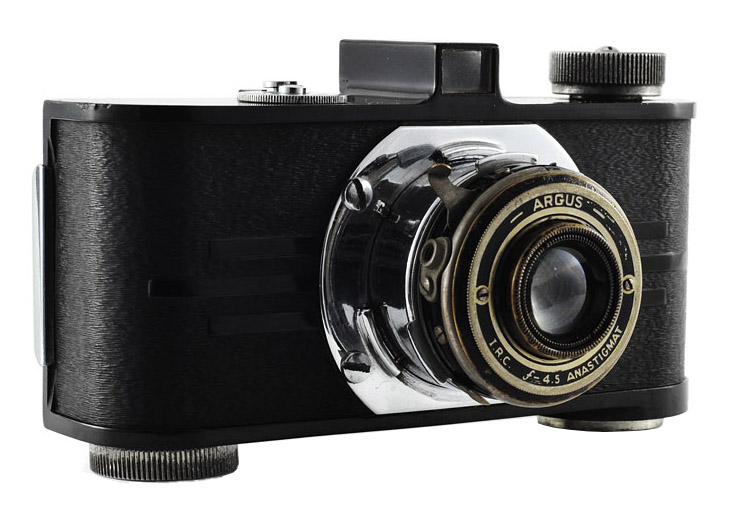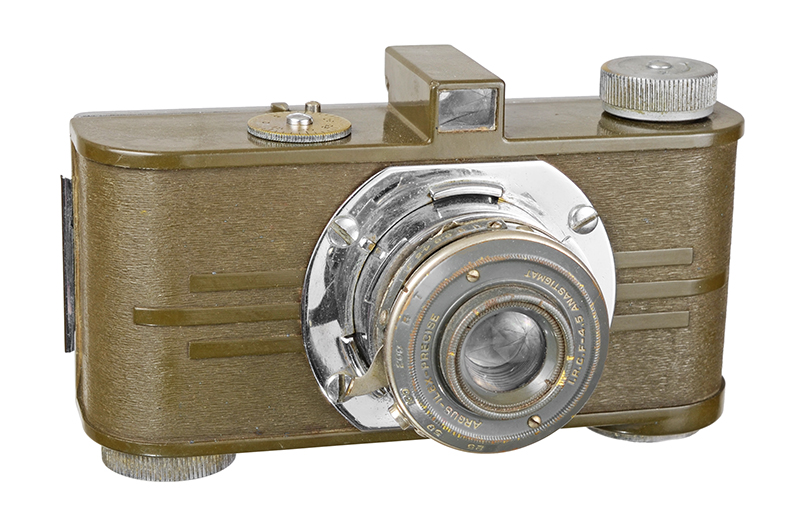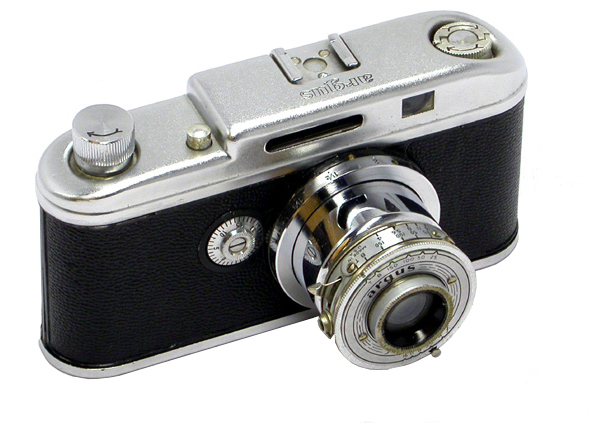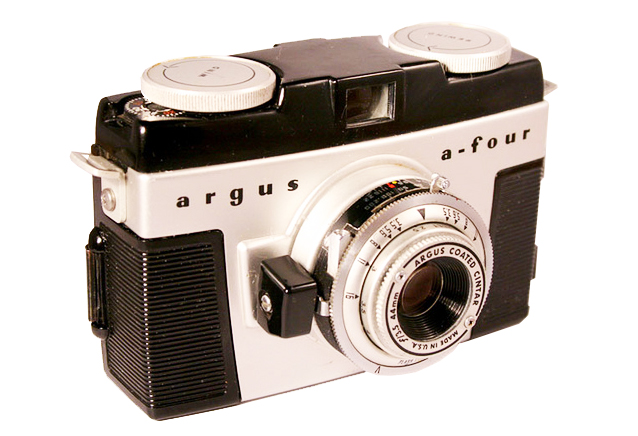Argus is an American maker of cameras and photographic products, founded in 1936 in Ann Arbor, Michigan. Argus originated as a subsidiary of the International Radio Corporation (IRC), founded by Charles Verschoor. Its best-known product was the C3 rangefinder camera, which enjoyed a 27-year production run and became one of the top-selling cameras in history. The company's Model A was the first low-cost 35 mm camera in the United States, and revolutionized the market..
Argus was acquired by Sylvania in 1959 but sold off in 1969, by which time it had ceased camera production; however, some rebadged cameras continued to be sold under the Argus name through the 1970s. More recently, the Argus brand has been reestablished and is used on a variety of inexpensive digital cameras made by Argus Camera Company, LLC., located in Illinois.
Argus A - 35mm Circa 1936
The Model A was the first low-cost 35 mm camera in the United States. This is one of the early cameras with a body made on molded bakelite plastic, featuring extensive art nouveaux patterns especially on the back panel.
The initial Argus A had a fixed focus lens, but later version offered adjustable focus. The very early Model A cameras, such as this one, had only one sprocket on the film advance.
Though Kodak offered superior lenses in the Kodak 35 series, Argus Model A and Model C cameras were by far the more popular cameras.
What in the world is bakelite?
Argus A - Olive Drab - 35mm Circa 1936
The Argus A was offered in several colors over the years including, black, white, grey, and olive-drab. It is unclear what the purpose of the olive-drab color was, though Kodak and Ansco produced this color for the Boy Scouts, but usually with the scouts' logo. Kodak produced a military version of the Kodak 35 in olive-drab, but all metal was blacked-out too. Regardless, this is rare and very desirable among collectors.
Argus C2 - 35mm Circa 1938
This is the Argus C with a refined range finder. Adding a gear between the lens and the range finder on the Model C made this a coupled range finder, putting this camera on the same level as the Kodak 35 RF. This C2 is very similar to the C3 form in which the C series went to war.
Argus A2B - 35mm Circa 1939
An upgrade (in some ways) to the Argus A after the failure of the Argus B, which was on the same body as the A with more features. The A2B had fewer features than the A or B, with only two position focus similar to the A. It did offer the first exposure meter system called an extinction meter.
Argus A3 Circa 1940
This is a transitional camera in that it has the metal body design that would be used later in the Argus A4 , but the inner components of the 1936 Argus A. To me it's a stylized Leica for the poor folk. I included it in our collection for the looks and price, so maybe the strategy wasn't too bad.
Argoflex Model E Circa 1940
The Argoflex Model E was introduced in 1940 by Argus, as the first consumer level TLR produced in the US. Following on the success of their 35 mm line which was considered the American Leica, Argus offered a US alternative to the successful German Rollieflex and Rolliecord cameras. It was more likely competitive with the latter consumer targeted product (see Rolliecord below). This was a well built camera with the innovative geared lens synchronization which would be popular in future cameras, especially in the 1950s. New plastic cameras with this configuration are trendy today. Kodak did not offer a similar product until after the war.
Argus CC Circa 1941
Argus CC, which stands for Color Camera, is interesting for its looks and that it is rare; made from 1941-1942. Why Color Camera? There is no real reason; the lens isn't coated for use with color film, and may have just been a name to catch on to the then new color film; and maybe to incite people to buy a more expensive camera. It is basically an A3 with a larger cover and window for the light meter. The guts are still the basic Argus A.
Argus C3 - Circa 1946
This is nearly identical to the prewar C2 (above), but the pre war and wartime had a silver metal cocking lever on the front instead of black plastic. These cameras were highly praised for rugged reliability and the C3 was nicknamed "The Brick".
Argus A-Four Circa 1953
The Argus A-Four is a plastic 35mm viewfinder camera made in the USA by Argus, from 1953 - 1956. It features a 4-speed shutter (+B) with flash sync made by Gauthier, and a 44mm f3.5 focusing Argus Cintar lens, stopping to f22[3].
Argus C44 Circa 1956
This is the swan song for the "serious" US manufactured Argus camera designs, but was only produced in 1956 and 1957. It has an impressive array of attachments and lenses, but it couldn't compete with the continued onslaught of superior foreign cameras especially the single lens reflex models. It featured truly interchangeable lenses, but the bayonet system is reputed to work poorly. This camera weds the lineage of the C series (bricks) with the lighter elegance of the A series, and replacing the C3 (brick) as the flagship camera in the Argus line.
Argus Seventy-Five Circa 1958
The Argus 75 is a nice vintage Twin Lens Reflex (TLR) camera. It has time and instant (aprox 1/125th second) shutter speeds and a fixed focus 75mm Argus Lumar lens. The shutter is cocked by winding the film, so you have to wind it before the shutter will fire. When it is cocked a red shutter cover is revealed behind the lens to tell the user the camera is ready, and to help prevent wasted frames. It takes 6cm x 6cm exposures. It was designed for 620 film, but it can be used with 120 film so some people still use these today.
Argus Matchmatic Circa 1958
The Matchmatic and Golden Shield, were produced from 1958 to 1966 These were sold with a selenium light meter attachment but were otherwise essentially identical to the Standard C3. Both models also featured distinctive finishes: two-tone tan and black leatherette on the Matchmatic and metalized PET film coating on the Golden Shield.
Argus C33 Circa 1959
The Argus C33 was only manufactured from 1959 - 1961 - it features a few rather bulky improvements to the original C3 model, such as a coupled light meter and interchangeable lenses. After the failure of the euro-styled C44 camera system, the C33 was a reversion to the "brick" style with a full system of light metering, interchangeable lenses, and other accessories.
Improvements included a lever film advance, rewind, four interchangeable bayonet lenses, an auxiliary viewfinder and a coupled light meter. It wasn't exactly a huge hit for Argus, and thus, complete Argus C33 outfits are rare and hard to find. Argus faced a dilemma of being locked into a style which dated back to the 1930s, but it had become the expectation of their customer base.
Argus Autronic I Circa 1962
Argus Autronic I 35mm camera is one of four Autronic models which evolved from the C33 but without the interchangeable lenses. These were rangefinder cameras with built in exposure metering. The other models are the Autronic C3 1960 - 1962, Autronic C35 1960 (only), and the Autronic II. The Autronic I and Autronic II were produced from 1962 to 1965.
One of this model camera was used by JFK assassination witness Phil Willis to make a series of pictures before, during and after the assassination on November 22, 1963. Willis was standing on the south side of Elm Street during the shooting.























